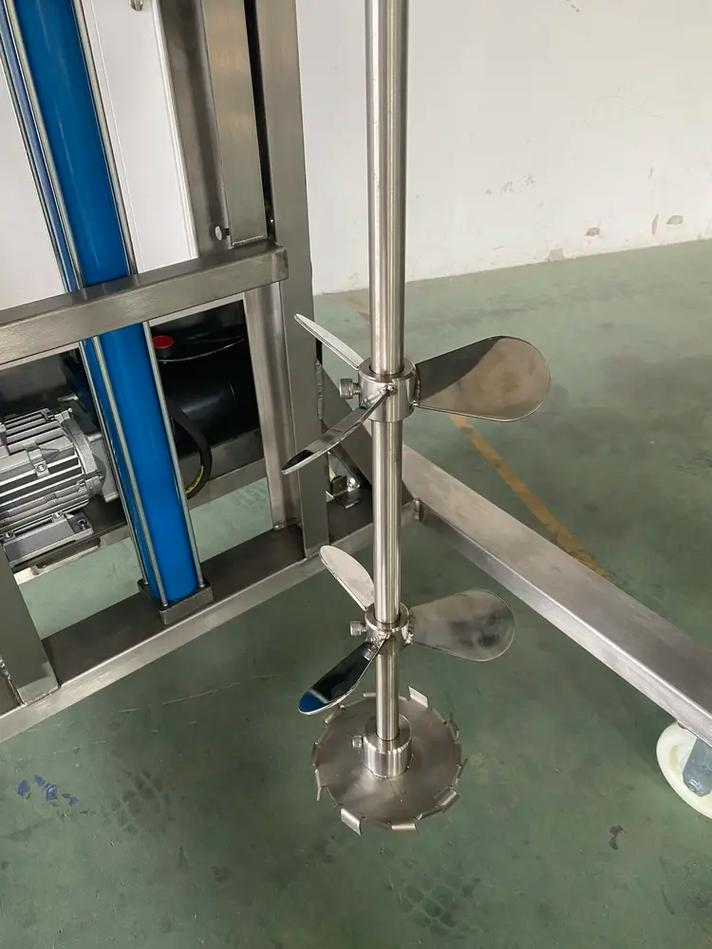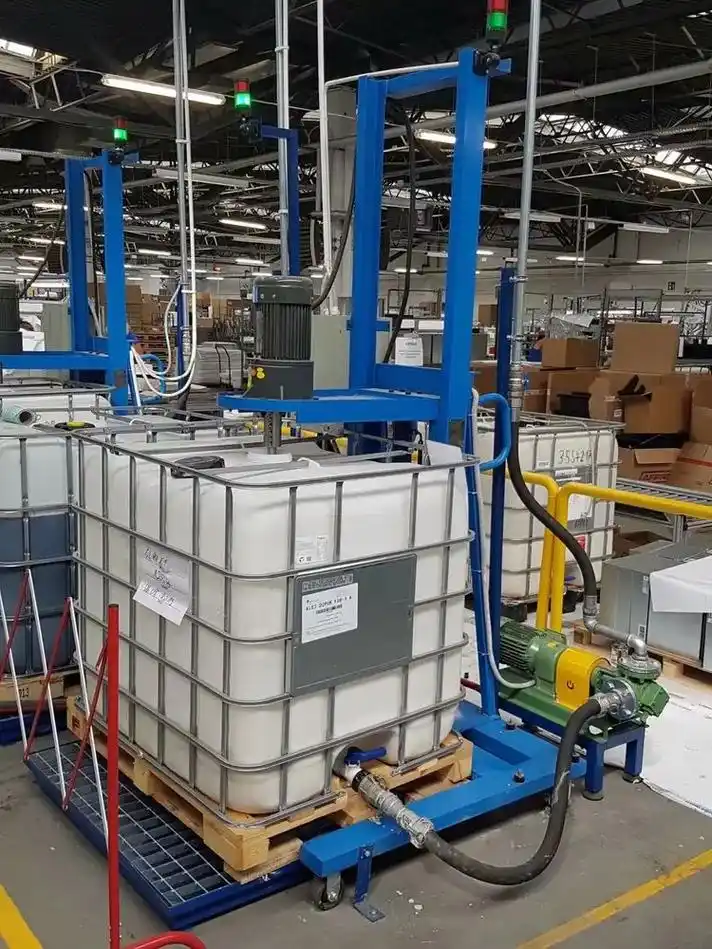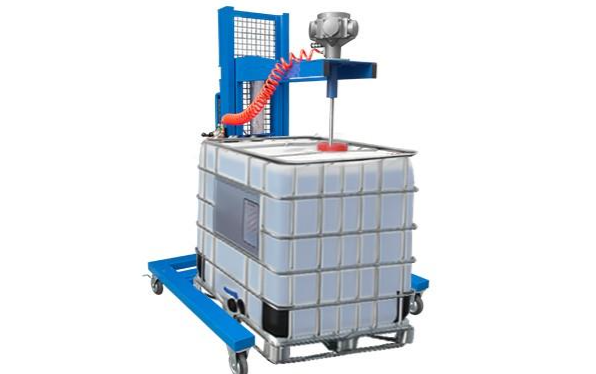An IBC (Intermediate Bulk Container) agitator is a mechanical device designed to mix, blend, homogenize, or suspend solids within liquids inside an IBC tote. Its primary purpose is to prevent settling, ensure a consistent mixture, and facilitate easy dispensing of the contents.
IBC agitator is essentially a motor-driven mixer that mounts onto the standard 2″ (or sometimes 4″) opening on the top of an IBC tote. It consists of a motor, a drive shaft, and an impeller (or mixing blade) that is submerged in the liquid.
Without agitation, many mixtures—like pigments, abrasive slurries, food ingredients, or chemicals—can separate, with solids settling to the bottom. This leads to clogged discharge valves, inconsistent product quality, and wasted material. The agitator solves this problem.
Motor: Typically an electric motor, often air-powered (pneumatic) for explosive or hazardous environments. Gear motors are used to achieve the correct torque and speed.
Drive Shaft: A long stainless steel (common grades 304 or 316) or sometimes coated shaft that extends from the motor down into the tote. Its length is designed to position the impeller correctly within the liquid.
Impeller: The “blade” that does the actual mixing. The design is critical and depends on the fluid viscosity and mixing goal (e.g., blending, suspending, shearing).
Mounting System: A clamp, flange, or threaded fitting designed to securely and safely seal the agitator to the standard IBC opening.
Guard: A safety guard that covers the rotating shaft and motor to prevent accidental contact.

There are two primary ways to categorize them:
A. By Mounting Style:
Top-Entry: The most common type. It mounts vertically on the top opening of the IBC.
Side-Mount: Less common. Used when top access is unavailable or for specific mixing needs in portable applications.
B. By Power Source:
Electric: Most common, offering a good balance of power, cost, and convenience. Require a nearby power outlet.
Pneumatic (Air-Powered): Essential for hazardous environments where sparks from an electric motor could cause an explosion. They are also powerful and can be easily speed-controlled.
Hydraulic: Used in remote locations or where high torque is needed, but less common for standard IBCs.
Battery-Operated (DC): Offers maximum portability, ideal for facilities where totes are moved around frequently.

Choosing the right agitator is critical for success. Consider:
Viscosity: This is the most important factor. Low-viscosity fluids (like water) need high-speed, low-torque agitation. High-viscosity fluids (like pastes or gels) require low-speed, high-torque motors with robust impellers.
Specific Gravity/Density: Heavier fluids require more power (torque) to agitate.
Mixing Goal: Are you simply keeping solids suspended (easy), fully homogenizing two liquids (moderate), or trying to dissolve a solid (which can be difficult)?
Container Size & Geometry: Standard IBCs are ~1000L, but agitators are made for smaller (200L) and larger (2000L) containers. The impeller must be sized correctly for the tank’s diameter.
Material of Construction: The shaft and impeller must be compatible with the fluid to avoid corrosion. 304 and 316 Stainless Steel are industry standards.
Hazardous Area Classification: Is the environment potentially explosive? If so, you must choose an ATEX or IECEx certified pneumatic or explosion-proof electric motor.
Portability: Will the tote be moved with the agitator attached? If so, a low-profile, lightweight, or DC battery model is best.
Secure Mounting: Always ensure the agitator is properly clamped and sealed to the IBC opening before starting.
Correct Submersion: The impeller must be fully submerged to avoid vortexing, splashing, and aerating the fluid, which can be dangerous or ruin the product.
Do Not Overfill: Leave adequate headspace (usually 10-15%) to allow the fluid to circulate without overflowing.
Regular Inspection: Check the shaft for damage or wear and ensure the impeller is tight.
Use the Guard: Never operate the agitator without the safety guard in place.
The primary advantages of IBC (Intermediate Bulk Container) agitators include improving efficiency, ensuring quality, reducing costs, and enhancing safety. The following is a detailed breakdown of their core benefits:
1. Product Consistency and Quality Assurance
This is the most fundamental advantage.
Preventing Sedimentation: Effectively maintains a uniform suspension of solid particles (such as pigments, fragrances, and active ingredients) in the liquid, preventing them from settling and clumping at the bottom of the container.
Uniform Mixing: Ensures consistent concentration and properties throughout the entire IBC contents, from top to bottom and from center to edge.
Result: The product dispensed or discharged is of the same quality every time, significantly reducing both intra- and inter-batch quality variations and ensuring final product reliability.
2. Significantly Improved Operational Efficiency
Ready-to-Use: Eliminates time-consuming manual or external remixing before dispensing, enabling continuous operation.
Reduced Downtime: Eliminates production interruptions and cleanup time caused by material blocking the outlet, resulting in a smoother process flow. Simplified Process: Combining mixing and storage into one process eliminates the additional step of transferring materials from one mixing vessel to an IBC.
3. Cost Reduction & Waste Minimization
Zero Material Waste: Virtually 100% of the IBC contents can be drained, allowing precious or expensive ingredients that settle to the bottom to be fully utilized.
Reduced Labor Costs: Automated mixing replaces laborious and time-consuming manual mixing, freeing up labor.
Reduced Product Loss: Eliminates defective or scrapped products due to uneven mixing.
4. Enhanced Safety & Ergonomics
Eliminating the Risks of Manual Mixing: Employees are protected from the risk of musculoskeletal injuries (MSDs) associated with heavy, repetitive manual mixing.
Enclosed Operation: The mixing process is performed within the sealed IBC, reducing operator exposure to hazardous chemicals or fumes and improving the working environment. Dedicated Explosion-Proof Options: For flammable and explosive environments, pneumatic or explosion-proof motor models (e.g., ATEX certified) are available, virtually eliminating the risk of electrical spark ignition.
5. Excellent Versatility & Flexibility
Wide Application Range: By selecting the appropriate model (motor power, shaft, and impeller type), it can handle materials ranging from low-viscosity water-based liquids to high-viscosity pastes and slurries.
Portable Design: Many IBC agitators are lightweight and can be easily switched between multiple IBC containers, allowing a single unit to service multiple tanks, providing a high return on investment.
Various Mounting and Power Options: Choose from electric, pneumatic (suitable for flammable environments), or battery-powered (suitable for locations without a power source) models to suit site conditions.
6. Durability & Low Maintenance
Simple Construction: Typically constructed from corrosion-resistant materials (such as 304 or 316 stainless steel), the robust design is easy to clean and maintain. Long service life: High-quality industrial-grade motors and mechanical transmission components ensure long-term stable operation of the equipment in harsh industrial environments.

The primary advantages of pneumatic agitators revolve around their safety, performance characteristics, and durability.
1. Intrinsic Safety – The Core Advantage
This is the greatest and most crucial advantage of pneumatic agitators.
Explosion-proof and spark-free: Pneumatic motors are driven by compressed air and produce absolutely no electrical sparks during operation. This makes them ideal for flammable and explosive environments (such as those with solvents, vapors, and dust), essentially eliminating any ignition source.
No Overheating Risk: Even in a stalled state, pneumatic motors will not overheat or burn out due to current overload, unlike electric motors, eliminating the risk of becoming an ignition source or igniting the material.
Naturally Suitable for Hazardous Areas: Expensive, explosion-proof certified enclosures are generally not required because the operating principle is inherently safe. This significantly reduces the cost and complexity of complying with regulations for use in hazardous areas.
2. Powerful Performance
Stepless Speed Regulation and Overload Protection: Stepless speed regulation is easily achieved with a simple throttle valve or air pressure regulator. More importantly, when overloaded, the motor will naturally stop without damage. Once the load decreases (for example, after the material being stirred moves), it automatically resumes operation, providing a built-in overload protection feature.
High Starting Torque: Pneumatic motors offer very high starting torque, making them particularly suitable for applications with high starting resistance, such as mixing high-viscosity fluids (such as pastes and resins) or stirring settled solids from a stationary state.
3. Durability and Reliability
Corrosion Resistance: Their relatively simple internal structure provides enhanced resistance to harsh environments. All-stainless steel pneumatic models are particularly suitable for highly corrosive chemical environments.
Submersible: Some specially designed pneumatic motors can even be temporarily operated underwater or in liquids without damage, a significant advantage in certain unforeseen circumstances.
4. Low Maintenance Cost
Simple Structure: Pneumatic motors are typically simpler than electric motors and gearboxes, with fewer parts and, therefore, lower maintenance requirements.
Clean Compressed Air Only: The only maintenance required is ensuring a dry, clean compressed air supply and regularly adding lubricant to the air conditioning unit (oil mist collector) at the air inlet (if the motor requires lubrication).
Based on the advantages described above, pneumatic agitators are primarily used in the following areas where safety and reliability are paramount:
1. Chemical Industry
This is the primary application area for pneumatic agitators.
Flammable and explosive media: Mixing liquids containing solvents (such as acetone, ethanol, toluene), monomers, or other volatile organic compounds (VOCs).
High-risk processes: Environments where flammable vapors or dust may be generated during reactions or mixing.
Examples include mixing paints, coatings, inks, adhesives, resins, and certain polymer solutions.
2. Pharmaceutical & Cosmetics Industry
Used for mixing formulations containing alcohol or other flammable solvents.
In cleanrooms or API (active pharmaceutical ingredient) production areas, where absolute explosion protection is required to ensure product purity and production safety.
3. Food & Beverage Industry
Primarily used in environments where there is a risk of food dust explosions, such as when mixing mixtures of powdered materials such as milk powder, starch, flour, and powdered sugar with liquids.
Air motors using food-grade lubricants also meet food safety requirements.
4. Mining & Metallurgy Industry
Mixing slurries containing flammable chemicals (such as certain extractants) during mineral processing.
In environments surrounding mines where flammable gases such as methane may be present.
5. Other Harsh Environments
Areas Requiring Frequent Washdowns: Due to its excellent water-resistance and corrosion-resistance, it is suitable for use in sites with high hygiene requirements and where frequent high-pressure water washing is required.
Remote Locations Without Power Supply: In some remote construction sites without a stable power supply but with an air compressor, a pneumatic agitator becomes the only option.
The decision to choose a pneumatic IBC agitator is often based on safety considerations rather than economics. If your process involves any form of flammable material (liquid, vapor, or dust), a pneumatic model is the safest, most reliable, and generally offers the lowest total compliance cost. For mixing common, non-hazardous liquids, electric agitators offer a more economical advantage due to their greater energy efficiency.